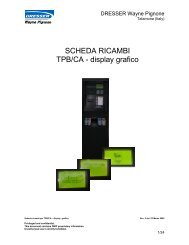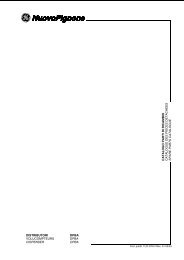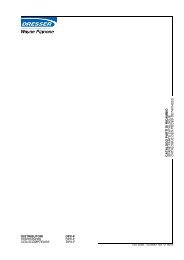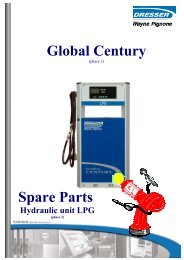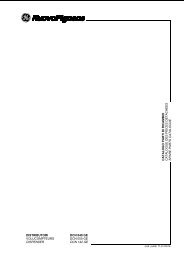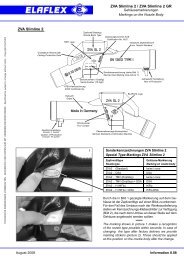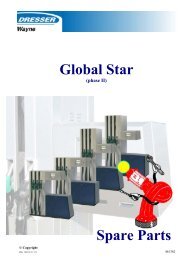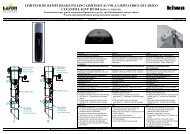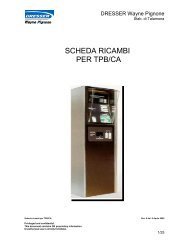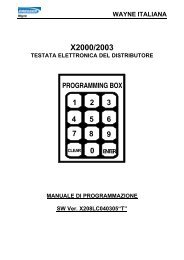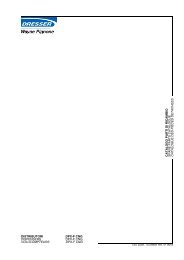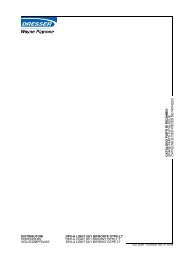TESTATA ELETTRONICA OTP-E.pdf
TESTATA ELETTRONICA OTP-E.pdf
TESTATA ELETTRONICA OTP-E.pdf
You also want an ePaper? Increase the reach of your titles
YUMPU automatically turns print PDFs into web optimized ePapers that Google loves.
5. TARATURA DEL MISURATORELa testata <strong>OTP</strong> Vers. E può essereutilizzata sia su distributori dotati dimisuratori che prevedono la possibilità diuna taratura di tipo meccanico (tramiteapposite operazioni), sia su distributori icui misuratori non prevedono possibilitàdi taratura. È per ovviare a quest’ultimocaso che la testata <strong>OTP</strong> Vers. E è statadotata di una opportuna funzione per lataratura elettronica del misuratore.5.1. Taratura elettronica delmisuratoreCome tutti i componenti meccanici, ancheil misuratore necessita di una taratura perrientrare nelle tolleranze di misura. Al fine diattribuire ad 1 impulso, che nominalmentevale 1 centilitro, il suo reale valore, bisognaoperare secondo la seguente proceduralogica:■ erogare una quantità di carburante,uguale o superiore ai 10 litri;■ inserire, attraverso tastierino a 4pulsanti o tastiera a 12 tasti, il valorerealmente erogato;■ a questo punto la testata calcola ilvalore reale dell’impulso; questovalore verrà memorizzato dalla testatain una apposita zona della memorianon volatile. Il valore del singolo impulsodeve rientrare in una tolleranza del± 2%. La testata non deve accettarenessun altro valore al di fuoridell’intervallo specificato.L’accesso alla procedura di taraturaelettronica è protetto da un appositocontatto (S2) su cui viene posto un sigillometrico; quando questo contatto è aperto,non è possibile entrare nella procedura;quando il contatto è chiuso, viene abilitatauna sola taratura del misuratore evengono inibite successive erogazioni. Inquesto modo si evita di dimenticare ilcontatto in posizione chiuso. Un’ulterioreprotezione contro la manomissione dellataratura viene ottenuta attraverso lamemorizzazione, in memoria non volatile,del numero di volte che si è entrati nellaprocedura, associando ad ogni ingresso ilvalore del totalizzatore elettronico cheassume così la funzione di orologio.5. METER CALIBRATIONThe computing head <strong>OTP</strong> E Vers. can beused on both fuel pumps equipped withmeters on which a mechanicalcalibration can be performed (byexecuting the appropriate operations), andon fuel pumps whose meters cannot becalibrated. In order to provide for pumpsof the latter type the <strong>OTP</strong> computing headE Vers. features a special function allowingfor meter electronic calibration.5.1. Meterelectronic calibrationAs all mechanical components do, metersas well need calibrating in order to conformto measurement tolerances.In order to assign to 1 pulse, the nominalvalue of which is 1 centilitre, its actualvalue, the following logical procedure mustbe observed:■ delivery a quantity of fuel, whichmust be more than or equal to 10 litres;■ enter, by means of the 4-button keypador of the 12-key keypad, the actuallydelivered value;■ now , the computing head calculatesthe real value of the pulse; this valuewill be stored by the computing head ina special area of its nonvolatile memory.The single pulse value must rangewithin a ± 2% tolerance.The computing head must not acceptany other value outside of that giveninterval.Access to the electronic calibrationprocedure is protected by a special (S2)contact, onto which a metrical seal isapplied; when this contact is open, theprocedure cannot be entered; when thiscontact is closed only one metercalibration is enabled, while successivedeliveries are inhibited. This way youcannot forget the contact in closed position.A further protection against calibrationtampering is obtained by storing intononvolatile memory how many times thecalibration procedure was entered, andby associating to each instance of enteringit the value of the electronic totalizer,which therefore takes on the function of aclock.5. TARAGE DU MESUREURLa tête de comptage <strong>OTP</strong> Vers. E peut êtreemployée sur des distributeurs équipés demesureurs qui prévoient un tarage de typemécanique (à l’aide d’une séried’opérations), ainsi que sur des distributeursdont les mesureurs ne prevoient pas lapossibilité de tarage. Pour obvier à ce derniercas, la tête de comptage <strong>OTP</strong> Vers. E a étépourvue d’une particulière fonction pour letarage électronique du mesureur.5.1. Tarage électroniquedu mesureurLe mesureur, comme tous les composantsmécaniques, a besoin d’un tarage pourpouvoir rentrer dans les tolérances demesure. Afin d’attribuer à 1 impulsion, dontla valeur est nominalement 1 centilitre, savaleur réelle, il faut agir selon la procéduresuivante:■ débiter une quantité de carburantsupérieure ou égale à 10 litres;■ introduire la valeur réelle du débit,au moyen du petit clavier à 4 boutonsou par le clavier à 12 touches;■ tout de suite la tête calcule la valeurréelle de l’impulsion; cette valeur seramémorisée par la tête de comptagedans une zone appropriée de lamémoire non volatile. La valeur dechaque impulsion doit rentrer dans unetolérance de ± 2%. La tête ne doit pasaccepter des valeurs en dehors del’intervalle spécifié.L’accès à la procédure de tarage électroniqueest protegé par un contact spécial (S2) surlequel est placé un cachet métrique; lorsquece contact est ouvert, il n’est pas possibled’entrer en procédure; quand le contact estfermé, on pourra exécuter un tarage uniquedu mesureur et les débits suivants serontinterdits. De cette façon on évite d’oublier lecontact en position de fermeture.Une protection ultérieure contre lesopérations frauduleuses de tarage estobtenue en mémorisant, dans la mémoirenon volatile, le nombre de fois qu’on estentré en procédure et en associant à chaqueentrée la valeur du totalisateur électroniquequi, par conséquent, prend la fonction d’unehorloge.NotaLa procedura descritta di seguito rispondealle Normative previste nel documentoOIML “Measuring Systems for Liquidsother than Water”.NoteThe following procedure complies with theRegulations provided by the OIML document“Measuring Systems for Liquids other thanWater”.NoteLa procédure décrite par la suite estconforme aux Normes prévues par ledocument OIML “Measuring Systems forLiquids other than Water”.- 23 -



